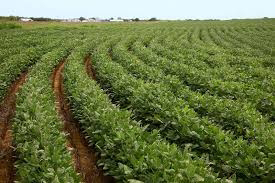Soybean Farming
Here are some key aspects of soybean farming:
Climate and Growing Conditions: Soybeans are typically grown in temperate and subtropical regions with a moderate growing season. They require a frost-free period of around 100 to 150 days and thrive in well-drained, loamy soil with a pH level between 6 and 7.
Cultivation: Soybeans can be cultivated using different methods, including conventional tillage, reduced tillage, and no-till practices. The choice of cultivation method depends on factors such as soil type, farm management practices, and environmental considerations.
Planting: Soybeans are usually planted in spring when soil temperatures reach around 50 to 60°F (10 to 15°C). The seeds are sown directly into the soil at a depth of around 1 to 1.5 inches (2.5 to 3.8 cm), with a spacing of 7 to 15 inches (18 to 38 cm) between plants, depending on the variety.
Crop Management: Effective crop management is essential for successful soybean farming. It includes activities such as weed control, pest and disease management, irrigation, and fertilization. Weed control can be achieved through mechanical cultivation or the use of herbicides. Common pests in soybean farming include aphids, bean leaf beetles, and soybean cyst nematodes.
Harvesting: Soybeans are typically harvested when the plants have matured, and the moisture content of the seeds is around 13% or lower. Harvesting is done using combines, which separate the seeds from the plants. Once harvested, the soybeans are dried to reduce moisture content further, typically through natural air drying or using specialized drying equipment.
Market and Uses: Soybeans have a wide range of uses. They can be processed to produce soybean oil, which is used for cooking, biodiesel production, and various industrial applications. The remaining soybean meal, after oil extraction, is a valuable source of protein for animal feed. Soybeans are also used in the food industry to produce products like tofu, soy milk, and soy-based meat substitutes.
Sustainability Considerations: Sustainable soybean farming practices aim to minimize environmental impact and promote long-term soil health. This includes implementing conservation practices, such as cover cropping, crop rotation, and using integrated pest management strategies to reduce chemical inputs.
Crop Rotation: Implementing a crop rotation system is beneficial for soybean farming. Rotating soybeans with other crops such as corn, wheat, or legumes helps break pest and disease cycles, improves soil fertility, and reduces the risk of soil erosion.
Nutrient Management: Proper nutrient management is essential for optimizing soybean yields. Conducting soil tests to determine nutrient deficiencies and using fertilizers accordingly can help maintain balanced soil fertility. Nitrogen-fixing bacteria called rhizobia form a symbiotic relationship with soybean plants, enabling them to convert atmospheric nitrogen into a form usable by the plant. Inoculating soybean seeds with rhizobia before planting can enhance nitrogen availability.
Disease Management: Soybeans can be susceptible to various diseases, including soybean rust, bacterial blight, and root rot. Monitoring for signs of disease, implementing preventive measures, such as planting disease-resistant varieties, and employing appropriate fungicides or other control methods when necessary can help manage disease outbreaks.
Pest Management: In addition to the pests mentioned earlier, soybean farming can also face challenges from insects like soybean aphids, Japanese beetles, and caterpillars. Monitoring pest populations and using integrated pest management (IPM) techniques, which involve a combination of cultural, biological, and chemical control measures, can help minimize crop damage.
Genetic Varieties: There are numerous soybean varieties available, each with different characteristics and adaptations to various growing conditions. Choosing the right variety for your specific region and farming goals, considering factors such as maturity group, disease resistance, and yield potential, can optimize crop performance.
Post-Harvest Handling: Proper post-harvest handling is crucial to maintain soybean quality. Ensuring adequate drying, cleaning, and storage conditions help prevent moisture damage, mold growth, and insect infestation. Storing soybeans at a consistent temperature and moisture level can preserve their quality for a longer period.
Market Considerations: Before starting soybean farming, it's important to assess market conditions and demand. Understanding local and international markets, identifying potential buyers, and staying informed about price trends and trade policies can help farmers make informed decisions regarding production volumes and marketing strategies.
Environmental Considerations: Sustainable soybean farming practices aim to minimize environmental impact. Conservation tillage, which involves reducing or eliminating soil disturbance during planting, helps prevent soil erosion and improves soil structure. Additionally, adopting water-saving irrigation techniques, such as drip irrigation or precision application methods, can optimize water use efficiency.
Remember, local agricultural extension services, universities, and agricultural organizations can provide region-specific information and best practices for soybean farming. Consulting with experienced farmers in your area can also provide valuable insights and practical knowledge for successful soybean cultivation.
Follow me more details
Click on the link 🔗🖇️👇👇











Comments
Post a Comment